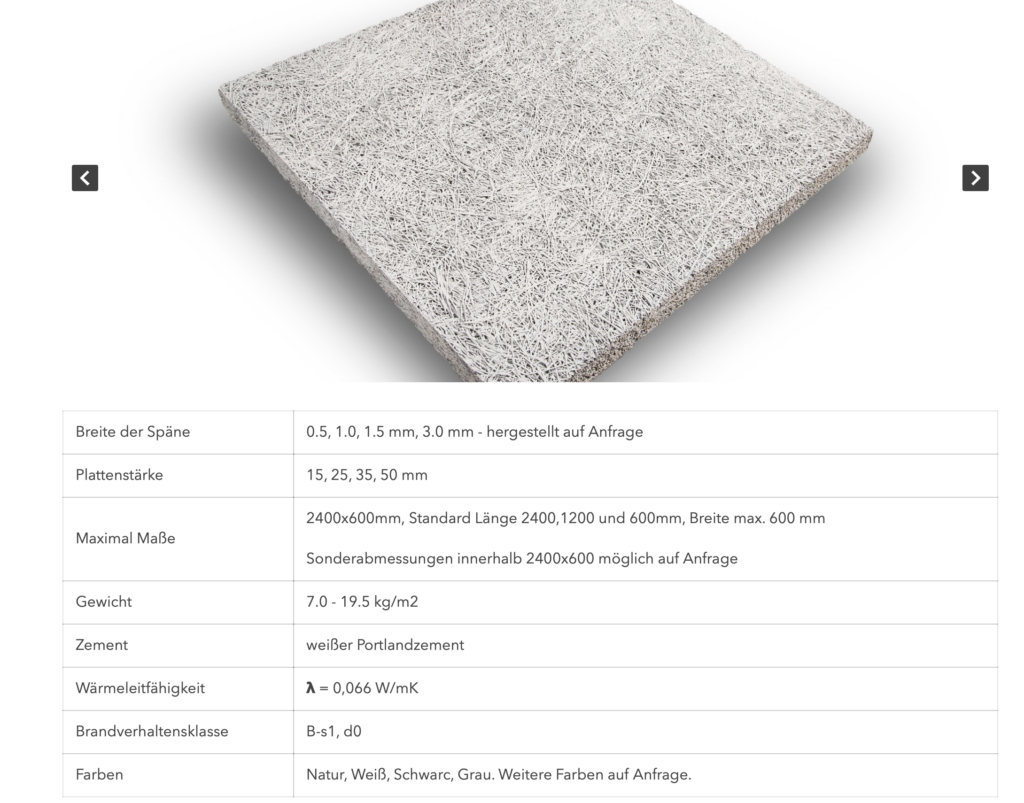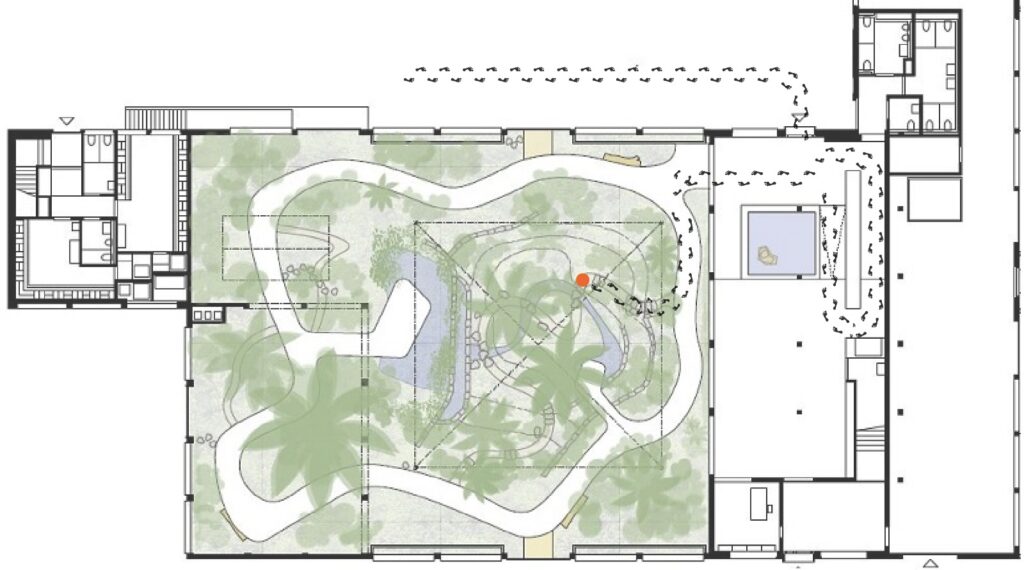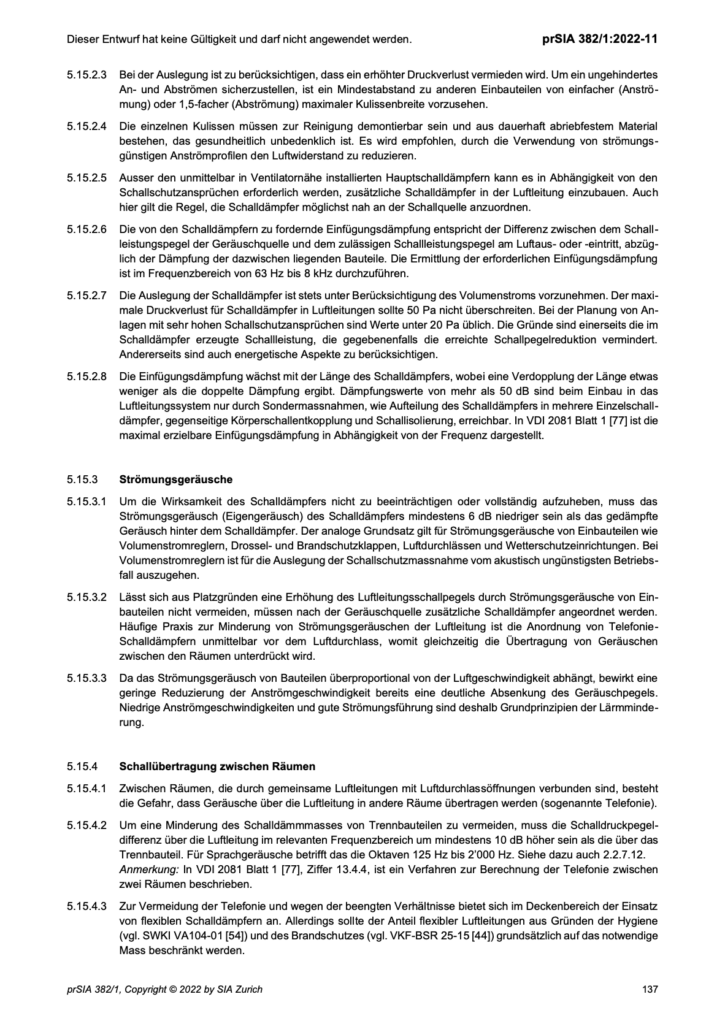01 Exploring Sound Qualities in Architectural Design
Location: Stadtgärtnerei, Sackzelg 25, 8047 Zürich
The Stadtgärtnerei is a traditional urban production company in Zurich-Albisrieden that offers free access to visitors 365 days a year. It creates a controlled atmosphere with regulated temperature, humidity, and light conditions, allowing plants to thrive.
Acoustic ‘slang’ terminology: Lush, Organic and Balanced, the overall auditory experience has a calming effect.
List of specific acoustic events:
- Rainfall on the roof: The sound of raindrops hitting the glass can be soothing.
- Leaves: while we pass by the plants, the leaves make the sound.
- Water sound: river in the greenhouse
- Birdsong: Birds may seek refuge or be attracted to the plants, adding a melodic element.
- Footsteps on concrete paths: Human activity can punctuate the natural soundscape.
The acoustics of a greenhouse are characterized by a unique combination of natural sounds and reverberation. The glass walls and ceiling can reflect and amplify sounds, creating a distinct acoustic environment. The plants themselves became the acoustic absorber of the whole room. Before entering the greenhouse, the waiting room has acoustic ceilings to provide quiet resting space. The water inside and outside of the greenhouse is very attractive. The fountain in the waiting room is the loud ambient sound. The small river inside the greenhouse constantly makes white noise. However, the rich sound inside of the greenhouse makes the atmosphere different. The harmonious blend of nature sounds, like rustling leaves and chirping birds, is interesting. It’s a space where the soundscape complements the visual experience of lush greenery.
Geometry: The greenhouse has a hip glass roof shape, and the walls are made of translucent materials. The height is designed to allow plants to grow vertically. The internal layout includes rows of plant beds and pathways for navigation. The geometry is optimized for light exposure and efficient use of space. The resting room outside is rectangular in shape with various ceiling heights.
The greenhouse resonates with a symphony of nature. The pattering of rain, the soft sound from the leaves, and the lively chatter of birds come together to create an enjoyable space. The occasional human presence adds a contrasting note, grounding the experience in a harmonious balance between cultivation and contemplation.
02 Exploring the Emotional Impact of Everyday Sounds
Presence of sound and the emotional impact:
- Raindrops
- The water flow of the fountain
- Visitor’s conversation
- Ambient
- Tranquil
- Vibrant and lively
The foyer or waiting area exudes a sense of enclosure, accentuated by the subdued rain sound. The clarity of visitor conversations, especially the vivid chatter of children, was obvious and can be loud. The water flow from the fountain becomes a focal point. When no one is in the foyer, the quietness amplifies the impact of every little movement, contributing to an intimate, contemplative atmosphere.
Inside the greenhouse, the soundscape is a stark contrast compared to the waiting room—louder rain sounds, muffled ambient noises, and birds. The reverberation time of the sound is longer due to the greenhouse’s expansive dimensions and high ceiling. The rain, hitting the glass roof, creates a dynamic and immersive auditory experience. The sound of the rain also becomes less distinct due to the large volumetric space of the greenhouse and plant buffers. This sheer yet enclosed volume may lead to discomfort as the sound from the ventilator can be overwhelming.
Nevertheless, these sounds connect us to nature, though in a way different from the forest atmosphere due to its openness.
03 Empirical and numerical estimation of room acoustic properties
1. Low Ceiling waiting room: RT60 =(0.26-0.05)*2=0.42s
2. Greenhouse: RT60 =(1.57-1.41)*3=0.48s
Width= 13m; Length=12m; Height = 6m
http://www.mh-audio.nl/Acoustics/ReverberationTime.html
04 Characterization of room acoustic treatments
Integrating acoustic measures is more important in the waiting foyer than in the greenhouse.
Visitor Foyer:
The ceiling, adorned with fibre panels, serves as a deliberate acoustic measure, absorbing mid to high-frequency sounds and contributing to a serene atmosphere of the waiting room. Soft cushions of the sofas also act as additional sound absorbers. Meanwhile, concrete walls and flooring reflect the sound together with the glass window panels. These reflections are diffused by the acoustic ceiling treatment and the furnishings. The varying ceiling height has a slight but unnoticeable influence on the reflection of the sound. A higher ceiling might contribute to a longer reverb. In this space, the sound is controlled.

Raytracing (ceiling height influence)


Green House:
Within the greenhouse, the architectural and natural elements interact to shape the acoustic landscape. The extensive glass roof and walls reflect the sound waves, but at the same time, its roof form, which is not flat, diffuses sound waves. The trees and plants inside also contribute to the sound diffusion, creating a muffled atmosphere. The soil and rocks on the ground provide surfaces that favour diffuse sound reflection.
05 Sound making – Sound walking
Part 1
Chosen Space: Forest
Object: Leaves
The space is the forest, where sound is reflected in all directions by the leaves themselves. Thus reaching the receiver from all directions.
Part 2
Location: Stadtgärtnerei, Sackzelg 25, 8047 Zürich
Time: 14/11/2023 around 5:00 pm

It was a dark and rainy day. The walk took place in the Stadtgaertnerei of the City of Zurich while not many people were there. Our walk started outside the greenhouse, covered by an umbrella under the rain. The predominant sound comes from the raindrops rhythmically splashing onto the surface of the umbrella.
As we step into the entrance foyer before the greenhouse, we realised a noticeable shift in sound quality. The outdoor and indoor is separated by the obvious volume of the sound due to the controlled environment indoors. The exterior noises of raindrops gradually diminish, creating a sense of enclosure. Inside, the foyer’s soundscape features the lively presence of adults and children together with a water fountain in the centre of the entrance space. The water fountain is the main constant sound source.
A prominent feature of the foyer’s acoustic design is the use of wood wool acoustic panels lining the ceiling. The panels’ functional purpose is to absorb excess reverberation and to ensure that the auditory experience remains pleasant and clear. The ceiling varies in height though it does not make an obvious difference to the acoustic of the space.
When entering the Greenhouse there was also a water fountain. Nevertheless the sound of the fountain was much softer and clearer. As the sound was dissipated, absorbed and softly reflected by the leaves. The soundscape within the greenhouse was much richer as one could not only hear the sound more clearly but also discover them as one approached the sound source. On the other side of the room was a ventilation installation, the sound of which progessively incremented as we approached the sound source.
Sound Walk photo sequence:

Norms
From our research, we did not find any norms applying to greenhouses themselves. There are various reasons we could imagine for this being the case:
- It is not a space where communication between people is part of the main function.
- It is not a space where people spend extended amounts of time working/living where the auditive sense has to be used or may be strained. Nevertheless, this argument is also questionable as people do work in this space, maintaining it.
- Within greenhouses, the plants themselves already act as acoustic instruments. Since they vary from greenhouse to greenhouse, this would be impossible to regulate as there are so many irregularities.
One norm (SIA 382/1 – 5.15) that is nevertheless applicable is regarding the ventilation systems. Since tropical greenhouses require a strongly monitored artificial climate, important technical ventilation systems must be implemented in these spaces.

Tangential thought:


Regulations of spaces are mainly anthropocentric. A thought experiment is to think how spaces would be designed if the acoustic necessities of animals and plants were also considered.

There are acoustic regulations for zoos that mention the sensibilities of certain animal species towards sound. However, specifics are implemented by specialists on a case-by-case basis.




